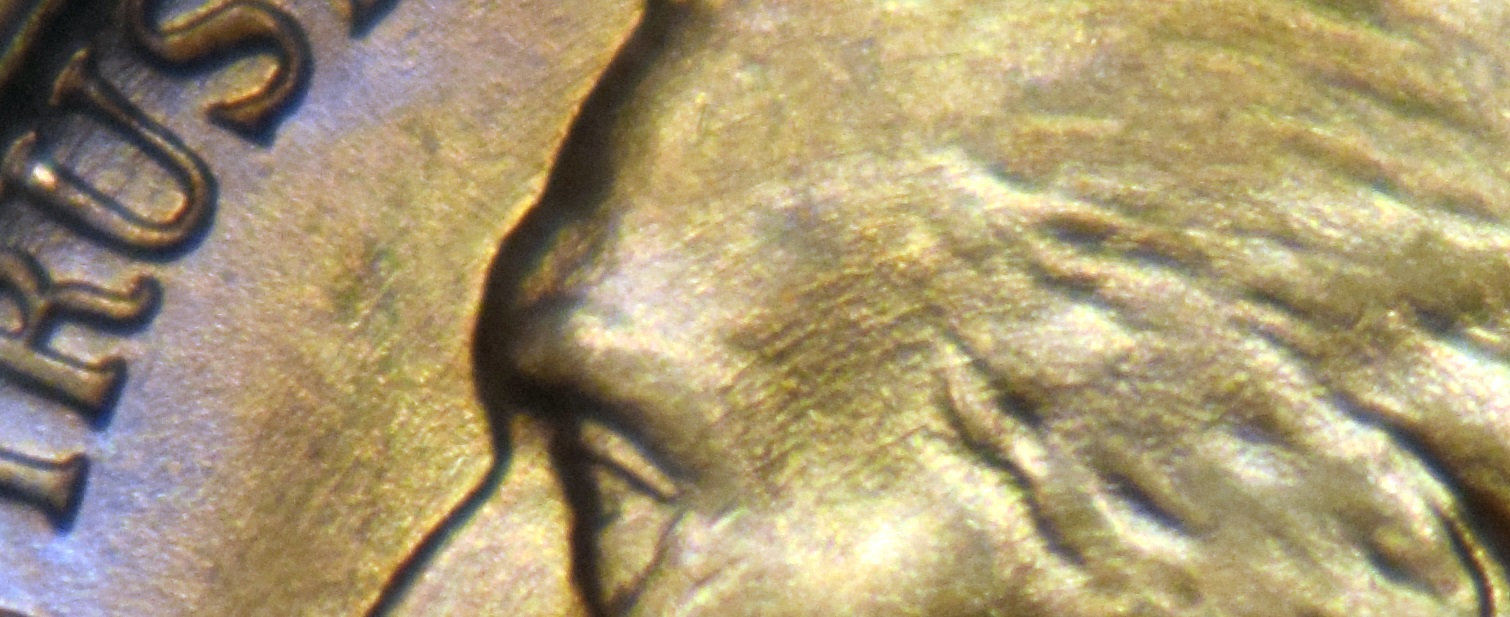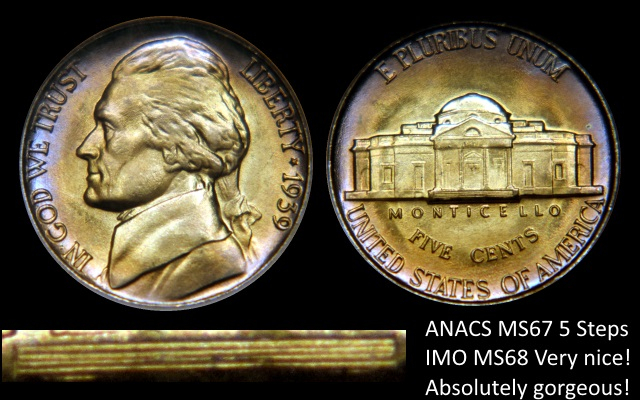Die Polish Lines
Do die polish lines affect the grade of a coin? How about the value of the coin once a grade is determined? In other words, will 2 close to identical coins (bag marks, toning, strike, luster etc.), one with marks and one without get the same grade and hold the same value? Thanks.
Jim
0
Comments
It has been known to prevent high gem grades if it's too "distracting." As for a sales premium, the holder grade is the grade. However, if the polishing is very severe or "distracting" some collectors have been known to pay substantial premiums for the right piece. It all depends on individual tastes.
Die Polish Lines
59Horsehide59Horsehide Posts: 218 ✭✭ February 23, 2018 10:38PM in Q & A Forum
Do die polish lines affect the grade of a coin? How about the value of the coin once a grade is determined? In other words, will 2 close to identical coins (bag marks, toning, strike, luster etc.), one with marks and one without get the same grade and hold the same value? Thanks.
Jim
Flag Quote · Disagree Agree Like LOL
Insider2Insider2 Posts: 4,595 ✭✭✭✭✭ February 25, 2018 5:06PM
In other words, will 2 close to identical coins (bag marks, toning, strike, luster etc.), one with marks and one without get the same grade and hold the same value?
I agree w/Chris. **There were "0" replies to the OP when I posted this:
Yes. As you know, die polish on a coin is not the same as marks, strike, luster, and eye appeal (toning?) that are used to determine the MS grade of a coin once the determination is made that the coin is actually Mint State.
Die polish can be very distracting as in some cases it can look like someone took an eraser to the field of a coin. Most of the time it is ignored when grading.
For some reason, this reply did not "Post" to the thread although it moved the OP's question to the top of the forum.
Mystery solved! The OP asked the same question in two places. I thought I was getting senile.
Sorry about the confusion. I do have this posted in the Q & A forum but was not getting any response. I couldn't figure out how to move it to U.S. Coins so I copied and pasted here.
I appreciate the replies to date. I asked because I have a roll of 1960-D Lincolns' and some of them have strong die polish lines on both the obverse and reverse. Got me to thinking how those lines might affect the grade/value.
Here is something interesting - I was just reading the Feb. 2018 issue of the "The Numismatist" and saw where there is a seminar scheduled at the upcoming ANA Convention. The title - "Coin Carnage: Understanding Problem Coins: Hairlines, Die Polish, etc." - page 73. In the details they state these coins should be avoided. Now I am really curious.
I love die polish lines on 1921 Peace Dollars. I have paid premiums on them for sure.
While they are not generally considered detrimental, depending on the severity and the grade of the coin, they can affect how potential buyers will bid - or not bid - on the coin. Cheers, RickO
It would help answer your questions if I knew something about you. How long have you been a collector? Are you in a coin club? Have you had any numismatic training?
I don't have my copy handy but here is the thing...the Key Word = UNDERSTANDING.
In my experience over 80% of the average run of the mill collectors and dealers cannot tell the difference between RAISED lines on a coin from the die or Hairlines/scratches INTO its surface from improper cleaning/damage. Not all coins with hairlines have been improperly cleaned.
Coins with die polish are not "problem coins".
That is a scary statistic but I have no reason to doubt it. And many of them can't tell the difference between a scratch on a plastic mint capsule or lens, and a scratch on the coin itself.
Keyword: My experience. I have not been across the Mississippi River or to the Left coast in fifteen years. Perhaps dealers/collectors on that side of the country are more informed. Sorry.
@Insider2
**"It would help answer your questions if I knew something about you. How long have you been a collector? Are you in a coin club? Have you had any numismatic training?"
**
Not sure what this has to do with my posting/questions. Never been screened before but here goes:
a) I acquired most of my collection from grandparents and other family members. This all started about 50 years ago.
b) I do belong to a coin club
c) I have not had any formal training. I joined the ANA six years ago but sat out for a year before renewing. I do not proclaim to know all there is to learn about coins but I have a pretty good library; belong to a couple forums; have learned lots from others; and will continue to so. I do not flip coins. I am not a dealer. I consider myself as maybe a step or two above the average collector (not sure that is fair).
"In my experience over 80% of the average run of the mill collectors and dealers cannot tell the difference between RAISED lines on a coin from the die or Hairlines/scratches INTO its surface from improper cleaning/damage. Not all coins with hairlines have been improperly cleaned."
I actually do no what a "die polish mark/line" is and how they are formed - polishing/sanding of the die (field area) which causes indented lines which when pressed into the coin cause the raised polish mark on the coin. These marks will travel under the devices on the coin thus differing them from scratches which can show on the devices and fields.
My question was not "what are die polish marks?". It was "what do die polish marks mean for the grade/value of a specific coin". I think I have a better understanding having asked the question.
Sure hope this helps. If you need more details in order to answer any future questions I have, please let me know.
I have an MS68* CAC Mercury dime with very noticeable die polish lines. Clearly, the lines won’t inhibit a very high grade in the eyes of NGC or CAC (and I’m sure PCGS as well). Die polish lines aren’t going to factor into the grade unless they have negative eye appeal. Some do look worse than others but most of the time I think they are neutral. I personally find them distracting on PL/DMPL coins, but I’m not sure that’s a widely held opinion.
Yikes, my apologies as I thought I had answered your question in the other forum where you asked: "In other words, will 2 close to identical coins (bag marks, toning, strike, luster etc.), one with marks and one without get the same grade and hold the same value?"
Yes. As you know, die polish on a coin is not the same as marks, strike, luster, and eye appeal (toning?) that are used to determine the MS grade of a coin once the determination is made that the coin is actually Mint State.
Die polish can be very distracting as in some cases it can look like someone took an eraser to the field of a coin. Most of the time it is ignored when grading.
I see I did not on this thread. I focused on your misunderstanding about the ANA class. The reason I asked personal questions was to judge your numismatic knowledge. Knowing it would save me a lot of time in my answer. I see you may have regarded my questions as a sign of disrespect. Sorry. In any case, I'm glad you got an answer.
It depends on individual preference.
I find heavy die polish to be a distraction, and a negative.
Sometimes the TPGs do too, sometimes they don't.
Die polish lines can be a very useful tool for variety attribution.
Time for an image!


Leo
The more qualities observed in a coin, the more desirable that coin becomes!
My Jefferson Nickel Collection